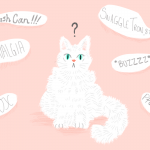“A collector acquiring the item that completes his collection signifies his own death.”
The person who said this (or something like it) is dead. He was French. And a philosopher; three reasons why we shouldn’t pay attention to him. But here I am, awake at six-thirty in the morning, wondering if marking 100 birds as ‘seen’ in “Peterson’s Field Guide to Birds of North America” signifies my death. I may not even get that far. Without coffee, death could be imminent.
My girlfriend, Tatum, and I are novice birders. Many of our peers struggle to understand the appeal. I say to them, “birding is like a mazy, long walk with friends occasionally punctuated with exhilarating moments. And if you don’t see any birds, you still had a lovely walk.”
The first time you leave home to spot tiny-brained specks, it’s likely you’ll be in the company of more experienced birders. Contrary to what you might expect, this can hurt your confidence. Everyone is an expert. Everyone has nicer gear. Everyone can see things you can’t.
“See it?”
“No.”
“It’s right there. On that branch. Follow my finger.”
“Where?”
“Oh, it flew away.”
That interaction will repeat until you think you’re cursed. But, don’t be dissuaded. The people around you who seem to know so much probably haven’t been birding as long as you think. Stick with it for one more session and you, too, will be able to confidently identify Red-winged Blackbirds and American Goldfinches. You, too, will grow accustomed to looking for movement, will notice irregularities in branches, will be able to scan a bush top-to-bottom. Like most activities, you’ll be surprised by how quickly you absorb the basics. And, as with most activities, you’ll sense that life isn’t long enough to achieve mastery.
On this particular morning, Tatum and I are equipped with our binoculars and a pocket guide. The pocket guide is a laminated, lightweight folding guide that is not exhaustive like Peterson’s, but covers the more common birds in the Chicago area. If we do see something that doesn’t match our pocket guide, Tatum makes a sketch of it; we list its characteristic features, and when we get home we consult Peterson’s and hope to make a positive identification.
Delays getting out of the house and stops for coffee and breakfast (all of which are my fault) cost us. We arrive at Magic Hedge at eight-thirty and all we see are Red-winged Blackbirds, American Robins, and a couple of toiling Downy Woodpeckers. Magic Hedge, for the uninitiated, is a series of connected thickets and prairie patches that projects out into the lake around Montrose Beach. Its official designation is Montrose Point Bird Sanctuary, but I’ve only ever heard it referred to as Magic Hedge.
Our previous trips to Magic Hedge had been a lot more fruitful. At the end of the School of the Art Institute of Chicago’s (SAIC) Spring Semester, Writing Faculty member Jill Riddell, Writing Program Alumnus Sophie Lucido Johnson and I had organized a morning bird walk for students in the MFA Writing program. We convened in the parking lot near Montrose Beach at six-thirty for coffee and breakfast. It was a fairly large party – a dozen in total – of students and their friends. We caught the Hedge during the warbler migration and had a grand old time spotting the Yellow-rumped Warbler and, Jill’s favorite, the Black and White Warbler. We even saw a juvenile Red-tailed Hawk that seemed to be enjoying the attention of many birders out and about that morning. The highlight of the trip was the rare Yellow-headed Blackbird, a bird that Jill, the most experienced birder among us, had never seen.
But now, in mid-July, as Tatum and I wind through the Hedge, there is no such abundance. Old faithfuls, Barn Swallows, zoom from tree-to-tree. We pass a lady.
“Seen anything?” We ask.
She lists the usual suspects. We commiserate with each other.
Tatum and I mosey on through the woods. We even consider giving up. It doesn’t seem to be our day.
In a section of the hedge where the thick canopy blocks out the brilliant light over the lake, Tatum stops abruptly.
“There.”
“Where?”
“There. Follow my finger.”
For what must be two or three minutes but feels like the length of a bad movie, I struggle to see what she’s seeing.
“C’mon, it’s right there,” she insists.
As if embarrassed on my behalf, the universe pulls back the curtain. And I see a bird I know that I have never seen before. It’s dead still. Usually, Tatum and I spot birds because our eyes track their movement. In this case, she spotted it cold. We watch it for many minutes. What could it be? It has a curved, yellow bill. Check. A longish tail. Check. We consult our guide.
Pliant, cooperative, it waits, allowing us to confirm and reconfirm that it is indeed a Yellow-Billed Cuckoo. A bird that is common, yes, but secretive. And one that neither of us have seen before. This is what we woke up for, the elation that punctuates the long walk. This is the addition to the collection. One step closer to one hundred.
We spend a long time gazing at it. I’m not sure what Tatum is thinking but I probably reflect on the entirety of my life in those minutes. It’s a moment to take stock, to feel fully, to be grateful for, and then, to move on from.
And our luck improves. We see a flock of Northern Rough-winged Swallows at rest, lazing around, like ten uniformed schoolboys waiting for the bus but secretly hoping it never shows.Later, in another part of the hedge, we encounter the same lady as before. This time, we have news to report. And she trots off after the Yellow-billed Cuckoo.
Late morning. Time to go home. The warm embrace of a long bath. And then, clean and dry, to open Peterson’s and inscribe a check mark against the Yellow-Billed Cuckoo. One step closer to … to what? Not sure. Maybe we’ll know when we get there.

















